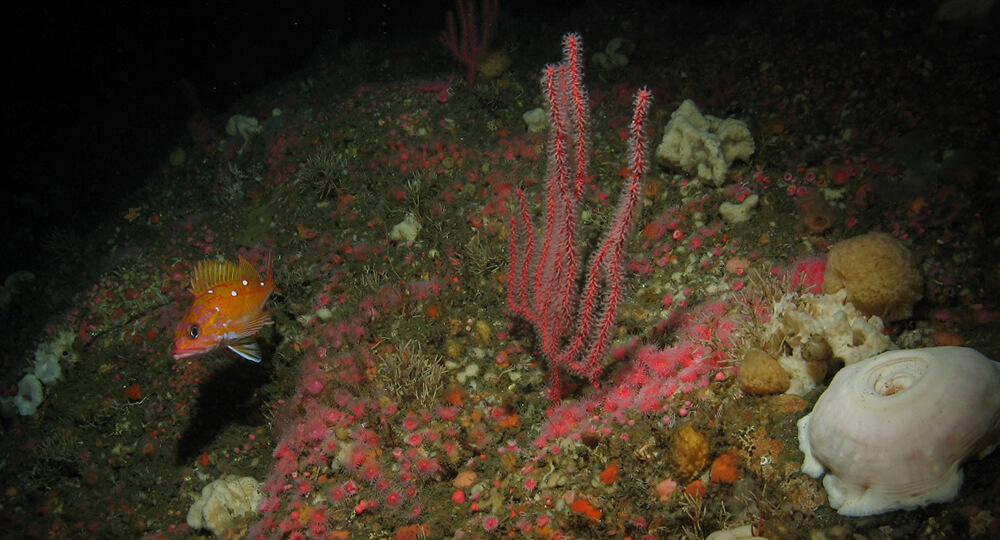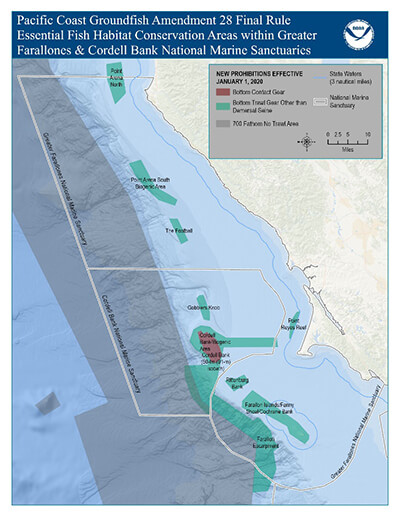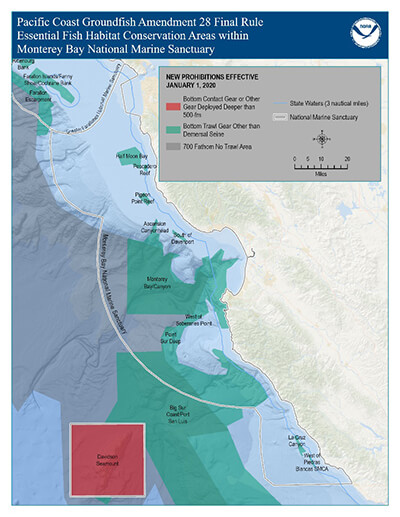Seafloor Habitat Conservation

The Greater Farallones National Marine Sanctuary participated in a decade-long review of pacific coast groundfish Amendment 28, Essential Fish Habitat Conservation Areas within sanctuary waters, providing critical seafloor, coral and sponge and fish assemblage data, that was vital to the decision to protect sanctuary habitats from bottom trawling.
The NOAA Fisheries final rule, in effect January 2020 includes Groundfish Essential Fish Habitat no-trawl designations that protect a total of 261.18 sq. miles of sanctuary waters. Five new areas are closed to bottom trawling throughout the sanctuary in locations with known higher densities of corals, sponges, sea pens and whips in soft, mixed, hard, rocky, and high-relief habitats. NOAA Fisheries also redesigned and modified the closure at Point Arena South Biogenic Area, changing the shape from 99.06 sq. miles to 36.08 square miles. Two additional areas retained their current closures: Fanny Shoal/Farallon Islands and Point Arena North.
The final action by NOAA Fisheries was designed with a diverse array of stakeholder input, including the relevant members of the fishing community and support from the Pacific Fishery Management Council.
Explore the Areas!
Four of these newly protected areas, Rittenburg Bank, Cochrane Bank, the Farallon Escarpment and "The Football" were characterized by the sanctuary through multi-beam and remotely operated vehicle (ROV) surveys between 2012 and 2016. Explore videos and story maps of Rittenburg Bank, Cochrane Bank, the Farallon Escarpment, and "The Football". To see more photos and videos of the Farallones Sanctuary’s deep sea benthic habitat visit the Sanctuary Integrated Monitoring Network (SIMoN) website.
Preliminary information about Point Arena South Biogenic Area, explored in October 2019, is available on Nautilus Live. In the coming years, the sanctuary plans to explore the fifth new closed area, Point Reyes Reef, and visit Point Arena North.
The sanctuary also plans to explore three new Essential Fish Habitat areas in the northern portion of Monterey Bay National Marine Sanctuary: Pescadero Reef, Pigeon Point Reef and Half Moon Bay Ascension Canyon.
We will continue to collaborate with scientists and local stakeholders to facilitate information flow to resource managers. We will share information with agencies, and in particular work with NOAA Fisheries to inform future decisions on changes to Essential Fish Habitat Conservation Areas within sanctuary waters to help minimize economic impact to the fishery in a practicable manner.
Deep-Sea Coral Research and Restoration Greater Farallones and Monterey Bay national marine sanctuaries
NOAA's Office of National Marine Sanctuaries published a final Restoration Plan for the YFD-70 Dry Dock for Greater Farallones and Monterey Bay national marine sanctuaries. This plan will allow for restoration of sanctuary resources injured as a result of the sinking of a 526 foot long dry dock in Monterey Bay National Marine Sanctuary.
Want more information?
Visit NOAA Fisheries to learn more about changes to bottom trawl fishing closures to minimize adverse effects of fishing, opening historically important fishing grounds to groundfish bottom trawling, and prohibition of fishing with bottom-contacting gear in deep waters off California to protect deep-water ecosystems, including deep-sea corals. You can also get maps of all the Groundfish Essential Fish Habitat no-trawl designations on the West Coast, including in other West Coast national marine sanctuaries and learn more about the Amendment 28 to the Pacific Coast Groundfish Fishery Management Plan process.



